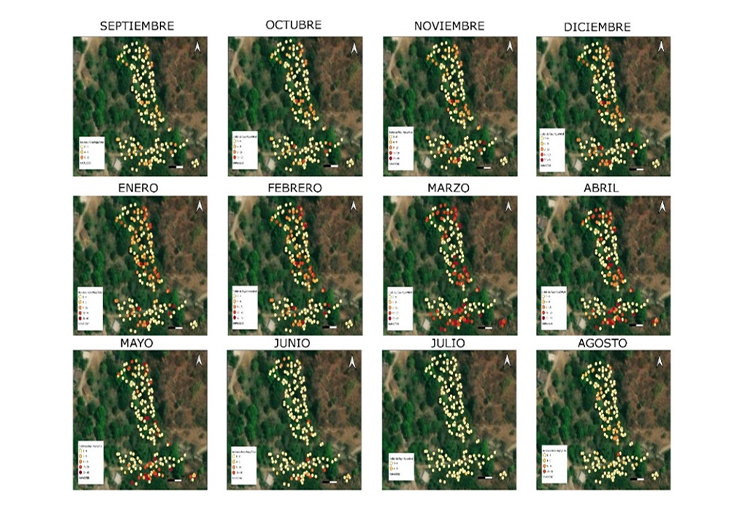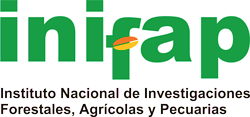GIS for the management of phytosanitary problems of coffee in Sultepec
DOI:
https://doi.org/10.29312/remexca.v16i5.3760Keywords:
agronomic potential, sustainable management, thematic mapsAbstract
Geographic information systems, as well as thematic maps, are used in precision agriculture for the collection, analysis and representation of data of interest; to enable crop efficiency and minimize the costs and resources used for different activities, such as pest and disease monitoring. The research aimed to design a geographic information system for the sustainable management of phytosanitary problems of coffee in the municipality of Sultepec, State of Mexico. Databases were created and the QGIS 3.24 Tisler program was used to make 108 thematic maps that represent a monthly average of the incidence of rooster’s eye, rust and iron spot in three sampled plots, in which the progress of each of the problems is observed during a year of sampling. These maps allowed us to identify well-marked sources of infection, as well as the months with the highest incidence, September to December for rooster’s eye and iron spot, with an infected area of up to 86%, and for rust, the months with the highest incidence were from January to April, reaching an infected area of up to 82%. The thematic maps allow the dissemination of the usefulness of technologies and the development of the most timely and effective decision-making in the management and control of coffee pests and diseases, with the challenge of sustainable crop management.
Downloads
References
Bautista, C. E. A.; Gutiérrez, C. E. V.; Ordaz, C. V. M.; Gutiérrez, C. M. C. y Cajuste, B. L. 2018. Sistemas agroforestales de café en Veracruz: identificación y cuantificación espacial usando SIG, percepción remota y conocimiento local. Terra Latinoamericana. 36(3):261-273. https://doi.org/10.28940/terra.v36i3.350.
Cantos, S. E. A.; Portilla, S. I. M.; Fajardo, E. P. G. y Lara, G. A. N. 2024. Evaluación multicriterio con aplicación de sistemas de información geográficas SIG para definir espacios de expansión urbana en el cantón Naranjito. Revista Científica Arbitrada Multidisciplinaria Pentaciencias. 6(6):93-109. https://doi.org/10.59169/pentaciencias.v6i6.1259.
CEDRSSA. 2019. Centro de Estudios para el Desarrollo Rural Sustentable y la Soberanía Alimentaria. Investigación interna, comercio internacional, el caso de México. Ciudad de México. 13 p. http://www.cedrssa.gob.mx/files/b/13/94Caf%C3%A9%20Producci%C3%B3n%20y%.
Choriego, M. R. A.; Hernández, S. V. S. y Martínez, S. D. N. 2023. Utilización de drones con aplicaciones tecnológicas en la agricultura por el sector bancario de El Salvador. Ceiba. 56(1):61-68. https://doi.org/10.5377/ceiba.v56i1.16361.
Coria-Contreras, J.; Mora-Aguilera, G.; Martínez-Bolaños, M.; Guzmán-Deheza, A., Acevedo-Sánchez, G. y Flores-Sánchez, J. 2014. Epidemiología de la roya del café (Hemileia vastatrix) en Soconusco, Chiapas. Revista Mexicana de Fitopatología. 32(1):43-53.
Figueroa-Figueroa, D. K.; Ramírez-Dávila, J. F.; Antonio-Némiga, X. y González-Huerta, A. 2020. Cartografía del aguacate en el sur del Estado de México mediante tratamiento digital de imágenes sentinel-2. Revista Mexicana de Ciencias Agrícolas. 11(4):865-879. https://doi.org/10.29312/remexca.v11i4.2173.
Figueroa-Figueroa, D. K.; Ramírez-Dávila, J. F.; Antonio-Némiga, X. y Serrato-Cuevas, R. 2024. Modelo espacial de áreas potenciales para plantaciones de aguacate en el Estado de México. Revista Mexicana de Ciencias Agrícolas. 15(5):1-6. https://doi.org/10.29312/remexca.v15i5.3515.
Goyes-Chávez, D. M.; Jaramillo-Molina, C. y Arango-Pastrana, C. A. 2022. Evaluación espacial de zonas potenciales de centros de distribución de cafés especiales, caso del Departamento de Nariño-Colombia. Revista EIA. 19(38):1-22. https://doi.org/10.24050/reia.v19i38.1542
Jiménez-Moya, G. E.; León, C. A.; Piñero, P. P. Y. y Romillo, T. A. 2016. Sigespro: Sistemas de Información Geográfica para controlar proyectos. Revista Cubana de Ciencias Informáticas. 10(2):181-195. http://scielo.sld.cu/scielo.php?script=sci-arttext&pid=S222718992016000200012&Ing=es&tlng=pt.
Lokers, R.; Knapen, R.; Janssen, S.; Van-Randen, Y. and Jansen, J. 2016. Analysis of big data technologies for use in agro-environmental science. Environmental Modelling & Software. 84(1):494-504. https://doi.org/10.1016/j.envsoft.2016.07.017.
Martínez-Martínez, N.; Ramírez-Dávila, J. F.; Mejía-Carranza, J.; Vera-Noguez, S. y Ramírez-Chimal, J. 2023. Ahuacatl: aplicación móvil para determinar la distribución espacial de problemas fitosanitarios en aguacate. Revista Mexicana de Ciencias Agrícolas. 14(3):471-476. https://doi.org/10.29312/remexca.v14i3.3052.
Mora, A. G.; Acevedo, S. G.; Coria, C. J.; González, G. R.; López, B. A. y López, J. M. 2015. Alertas tempranas para el manejo de focos de roya del cafeto en México. Revista Mexicana de Fitopatología. 33(1):62-70.
Orozco, Ó. A. y Ramírez, G. L. 2016. Sistemas de información enfocados en tecnologías de agricultura de precisión y aplicables a la caña de azúcar, una revisión. Revista Ingenierías Universidad de Medellín. 15(28):103-124. https://doi.org/10.22395/rium.v15n28a6.
Pérez-García, C. A.; Pérez-Atray, J. J.; Hernández-Santana, L.; Gustabello-Cogle, R. y Becerra-Armas, E. 2019. Sistema de información geográfica para la agricultura cañera en la provincia de Villa Clara. Revista Cubana de Ciencias Informáticas. 13(2):30-46. http://scielo.sld.cu/scielo.php?script=sci-arttext&pid=S222718992019000200030&lng=es&tlng=en.
Pérez-Constantino, A.; Ramírez-Dávila, J. F.; Gutiérrez-Rodríguez, F. y Pérez-López, D. 2024. Comportamiento espacial de roya del cafeto en Sultepec, Estado de México, México. Revista Acta Agrícola y Pecuaria. 10(1):1-12. https://doi.org/10.30973/aap/2024.10.0101004.
Pino, M. E. 2023. Comportamiento espacial de ojo de gallo Mycena citricolor, en cafetales del municipio de Sultepec, Estado de México. Café Mexiquense: Producción, mercado y política pública. 293-328 pp.
Rea-Sánchez, V.; Maldonado-Cevallos, C. y Villao-Santos, F. 2015. Los sistemas de información para lograr un desarrollo competitivo en el sector agrícola. Revista Ciencia Unemi. 8(13):122-129. https://doi.org/10.29076/issn.2528-7737vol8iss13.2015. 122-129 pp.
Shekhar, S. y Xiong, H. 2017. Enciclopedia de SIG. Medios de ciencia y negocios de Springer. https://doi.org/10.1007/978-3-319-23519-6.
SIAP. 2023. Servicio de Información Agroalimentaria y Pesquera. Producción Agrícola. Servicio de Información Agroalimentaria y Pesquera. http://www.siap.gob.mx/.
Silva, C. B.; Moraes, M. A. F. D. and Molin, J. P. 2011. Adoption and use of precision agriculture technologies in the sugarcane industry of São Paulo state, Brazil. Precision Agric. 12(1):67-81. https://doi.org/10.1007/s11119-009-9155-8.
SENASICA. 2024. Servicio Nacional de Sanidad, Inocuidad y Calidad Agroalimentaria. Muestreo y evaluación de variables de daño de Roya. https://www.royacafe.lanref.org.mx/.
Sosa-Escalona, Y.; Peña-Casadevalls, M. and Santiesteban-Toca, C. E. 2017. System for early warning of the effects of climate change on agriculture. Revista Cubana de Ciencias Informáticas. 11(3):64-76. http://scielo.sld.cu/scielo.php?script=sci-arttext&pid=S222718992017000300006&Ing=es&tlng=es.

Published
How to Cite
Issue
Section
License
Copyright (c) 2025 Revista Mexicana de Ciencias Agrícolas

This work is licensed under a Creative Commons Attribution-NonCommercial 4.0 International License.
The authors who publish in Revista Mexicana de Ciencias Agrícolas accept the following conditions:
In accordance with copyright laws, Revista Mexicana de Ciencias Agrícolas recognizes and respects the authors’ moral right and ownership of property rights which will be transferred to the journal for dissemination in open access. Invariably, all the authors have to sign a letter of transfer of property rights and of originality of the article to Instituto Nacional de Investigaciones Forestales, Agrícolas y Pecuarias (INIFAP) [National Institute of Forestry, Agricultural and Livestock Research]. The author(s) must pay a fee for the reception of articles before proceeding to editorial review.
All the texts published by Revista Mexicana de Ciencias Agrícolas —with no exception— are distributed under a Creative Commons License Attribution-NonCommercial 4.0 International (CC BY-NC 4.0), which allows third parties to use the publication as long as the work’s authorship and its first publication in this journal are mentioned.
The author(s) can enter into independent and additional contractual agreements for the nonexclusive distribution of the version of the article published in Revista Mexicana de Ciencias Agrícolas (for example include it into an institutional repository or publish it in a book) as long as it is clearly and explicitly indicated that the work was published for the first time in Revista Mexicana de Ciencias Agrícolas.
For all the above, the authors shall send the Letter-transfer of Property Rights for the first publication duly filled in and signed by the author(s). This form must be sent as a PDF file to: revista_atm@yahoo.com.mx; cienciasagricola@inifap.gob.mx; remexca2017@gmail.
This work is licensed under a Creative Commons Attribution-Noncommercial 4.0 International license.


